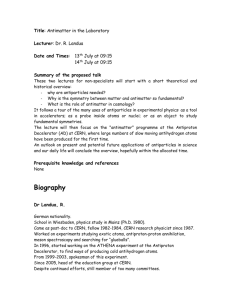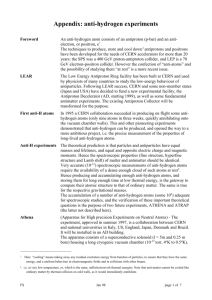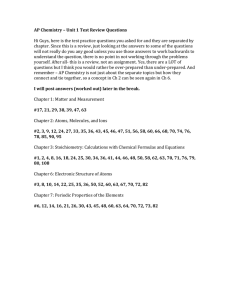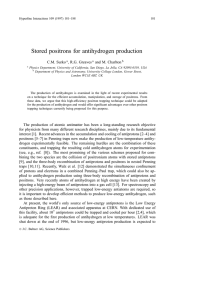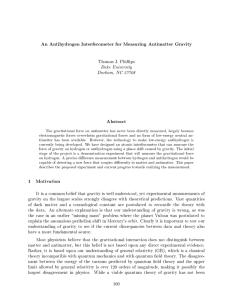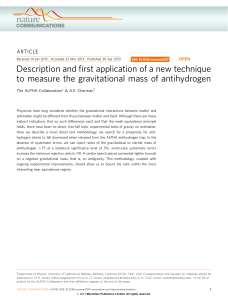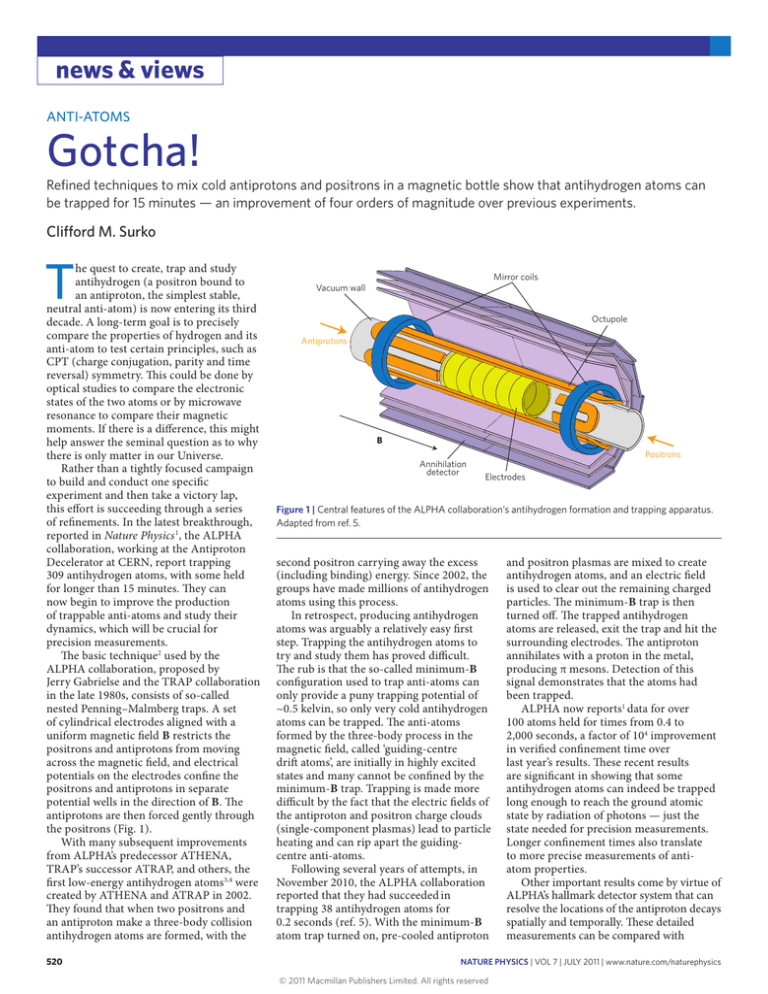
news & views
ANTI-ATOMS
Gotcha!
Refined techniques to mix cold antiprotons and positrons in a magnetic bottle show that antihydrogen atoms can
be trapped for 15 minutes — an improvement of four orders of magnitude over previous experiments.
Clifford M. Surko
T
he quest to create, trap and study
antihydrogen (a positron bound to
an antiproton, the simplest stable,
neutral anti-atom) is now entering its third
decade. A long-term goal is to precisely
compare the properties of hydrogen and its
anti-atom to test certain principles, such as
CPT (charge conjugation, parity and time
reversal) symmetry. This could be done by
optical studies to compare the electronic
states of the two atoms or by microwave
resonance to compare their magnetic
moments. If there is a difference, this might
help answer the seminal question as to why
there is only matter in our Universe.
Rather than a tightly focused campaign
to build and conduct one specific
experiment and then take a victory lap,
this effort is succeeding through a series
of refinements. In the latest breakthrough,
reported in Nature Physics 1, the ALPHA
collaboration, working at the Antiproton
Decelerator at CERN, report trapping
309 antihydrogen atoms, with some held
for longer than 15 minutes. They can
now begin to improve the production
of trappable anti-atoms and study their
dynamics, which will be crucial for
precision measurements.
The basic technique2 used by the
ALPHA collaboration, proposed by
Jerry Gabrielse and the TRAP collaboration
in the late 1980s, consists of so-called
nested Penning–Malmberg traps. A set
of cylindrical electrodes aligned with a
uniform magnetic field B restricts the
positrons and antiprotons from moving
across the magnetic field, and electrical
potentials on the electrodes confine the
positrons and antiprotons in separate
potential wells in the direction of B. The
antiprotons are then forced gently through
the positrons (Fig. 1).
With many subsequent improvements
from ALPHA’s predecessor ATHENA,
TRAP’s successor ATRAP, and others, the
first low-energy antihydrogen atoms3,4 were
created by ATHENA and ATRAP in 2002.
They found that when two positrons and
an antiproton make a three-body collision
antihydrogen atoms are formed, with the
520
Mirror coils
Vacuum wall
Octupole
Antiprotons
B
Annihilation
detector
Positrons
Electrodes
Figure 1 | Central features of the ALPHA collaboration’s antihydrogen formation and trapping apparatus.
Adapted from ref. 5.
second positron carrying away the excess
(including binding) energy. Since 2002, the
groups have made millions of antihydrogen
atoms using this process.
In retrospect, producing antihydrogen
atoms was arguably a relatively easy first
step. Trapping the antihydrogen atoms to
try and study them has proved difficult.
The rub is that the so-called minimum-B
configuration used to trap anti-atoms can
only provide a puny trapping potential of
~0.5 kelvin, so only very cold antihydrogen
atoms can be trapped. The anti-atoms
formed by the three-body process in the
magnetic field, called ‘guiding-centre
drift atoms’, are initially in highly excited
states and many cannot be confined by the
minimum-B trap. Trapping is made more
difficult by the fact that the electric fields of
the antiproton and positron charge clouds
(single-component plasmas) lead to particle
heating and can rip apart the guidingcentre anti-atoms.
Following several years of attempts, in
November 2010, the ALPHA collaboration
reported that they had succeeded in
trapping 38 antihydrogen atoms for
0.2 seconds (ref. 5). With the minimum-B
atom trap turned on, pre-cooled antiproton
and positron plasmas are mixed to create
antihydrogen atoms, and an electric field
is used to clear out the remaining charged
particles. The minimum-B trap is then
turned off. The trapped antihydrogen
atoms are released, exit the trap and hit the
surrounding electrodes. The antiproton
annihilates with a proton in the metal,
producing π mesons. Detection of this
signal demonstrates that the atoms had
been trapped.
ALPHA now reports1 data for over
100 atoms held for times from 0.4 to
2,000 seconds, a factor of 104 improvement
in verified confinement time over
last year’s results. These recent results
are significant in showing that some
antihydrogen atoms can indeed be trapped
long enough to reach the ground atomic
state by radiation of photons — just the
state needed for precision measurements.
Longer confinement times also translate
to more precise measurements of antiatom properties.
Other important results come by virtue of
ALPHA’s hallmark detector system that can
resolve the locations of the antiproton decays
spatially and temporally. These detailed
measurements can be compared with
NATURE PHYSICS | VOL 7 | JULY 2011 | www.nature.com/naturephysics
© 2011 Macmillan Publishers Limited. All rights reserved
news & views
numerical simulations of the trajectories
of antihydrogen atoms to help understand
the formation and trapping processes in
more detail. The results are consistent with
antihydrogen atoms in thermal equilibrium
at the temperature of the positrons from
which they were formed.
So why now and not earlier?
Experimenters have become much more
adept over the years in creating, cooling
and compressing antiproton and positron
plasmas. Furthermore, the ALPHA
collaboration used a novel auto-resonance
technique to combine the antiprotons
and positrons. This technique forces the
antiprotons through the positron plasma
very gently, creating colder, more trappable
antihydrogen atoms. Less is also better:
the experiments use relatively small
clouds of antiprotons (104) and positron
plasmas (106) to minimize the effects of
unwanted electric fields. Both species are
evaporatively cooled before mixing.
Still, there is enormous room for
improvement. Only one atom is formed in
every two mixing cycles, and the positron
(and thus the antihydrogen) temperature is
80 times the atom-trap well depth. Learning
how to create lower-energy antihydrogen
atoms would be a huge advance. This might
be done by further refining the present
scheme, or perhaps by using another
antihydrogen production scheme altogether
(for example, collisions of high-Rydbergstate positronium atoms with antiprotons)6.
Another consideration is the octupole
magnetic field of the ALPHA minimum-B
atom trap. Although probably critical for
anti-atom creation, it has a broad potential
minimum for the anti-atoms. Some
precision measurements require atoms
that are localized on the magnetic axis, so
perhaps an octupole trap for antihydrogen
formation and initial trapping, and a
quadrupole trap for long-term studies will
turn out to be preferable.
In the broader picture, this paper marks
great progress in the quest to compare with
precision the properties of antihydrogen
with that of its ordinary matter cousin.
However, there may well be more twists in
the road before this immensely challenging
goal is achieved.
❐
Clifford M. Surko is in the Department of Physics,
University of California at San Diego, La Jolla
California 92093-0319, USA.
e-mail: csurko@ucsd.edu
References
1.
2.
3.
4.
Andresen, G. B. et al. Nature Phys. 7, 558–564 (2011).
Gabrielse, G. et al. Phys. Lett. A 129, 38–42 (1988).
Amoretti, M. et al. Nature 419, 456–459 (2002).
Gabrielse, G. et al. Phys. Rev. Lett. 89, 213401 (2002).
5. Andresen, G. B. et al. Nature 468, 673–677 (2010).
6. Storry, C. H. et al. Phys. Rev. Lett. 93, 263401 (2004).
Published online: 5 June 2011
ADAPTIVE OPTICS
Although cone cells are more important
for everyday vision, rod cells make up
the vast majority (approximately 95%)
of the photoreceptors of the human eye.
Rods are much more sensitive than cones.
So sensitive, in fact, that they are able to
respond to individual photons, giving us
the ability to see in low-light conditions.
And they are responsible for detecting
movement in our peripheral vision.
But, owing to their small size (around
2 μm in diameter) and the optical distortions
introduced by other components of the
eye, resolving individual rod cells in living
eyes using conventional medical imaging
techniques is practically impossible. This
makes it difficult to diagnose the early
stages of disease in these cells in order to
treat them and prevent irreversible damage.
However, Alfredo Dubra and colleagues
have now developed a microscope that
is able to collect detailed images of the
mosaic of photoreceptors in the retinas
of living subjects (Biomed. Opt. Express 2,
1864–1876; 2011 and Biomed. Opt. Express
2, 1757–1768; 2011). It relies on a technique
known as adaptive optics, pioneered by
astronomers to correct for distortions
introduced by the atmosphere and produce
sharp images of the heavens using Earthbound telescopes.
UNIVERSITY OF ROCHESTER / BIOMEDICAL OPTICS EXPRESS
Retinal rods resolved
Their microscope — known as a confocal
adaptive-optics scanning ophthalmascope
— works in three stages: scanning a focused
beam of light across the subject’s retina;
measuring variations in the wavefront of
the reflected light, which are introduced
by imperfections in the lens and cornea at
the front of the eye, and then correcting
for these perturbations with deformable
mirrors. The result is retinal images with
resolutions approaching the diffraction
limit for the wavelengths of light used.
Both the small cones at the centre of
NATURE PHYSICS | VOL 7 | JULY 2011 | www.nature.com/naturephysics
© 2011 Macmillan Publishers Limited. All rights reserved
the retina (pictured left) and the small
rods surrounding larger cones at the
retina’s periphery (pictured right) are
clearly resolved.
Dubra et al. expect that this ability to
routinely collect detailed images of retinal
structures in a clinical setting will make it
possible to diagnose retinal disease earlier,
and to generate a wealth of previously
inaccessible data for the development of
better treatments.
ED GERSTNER
521

